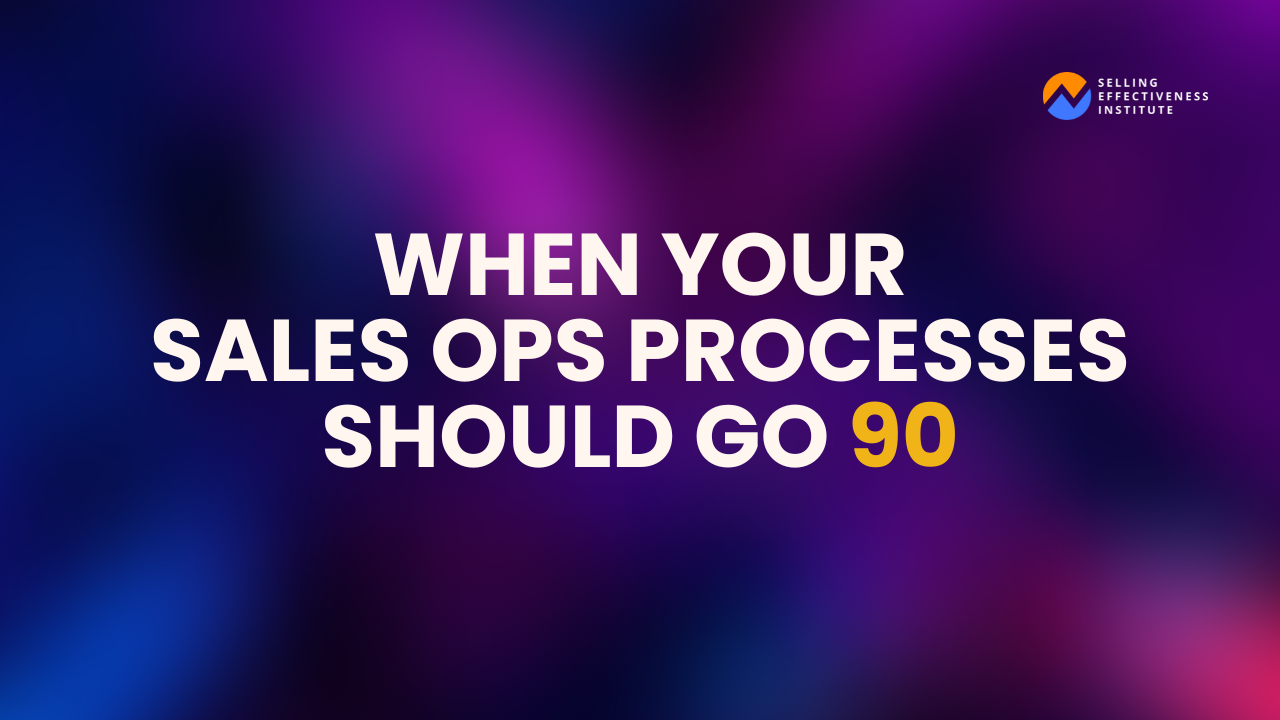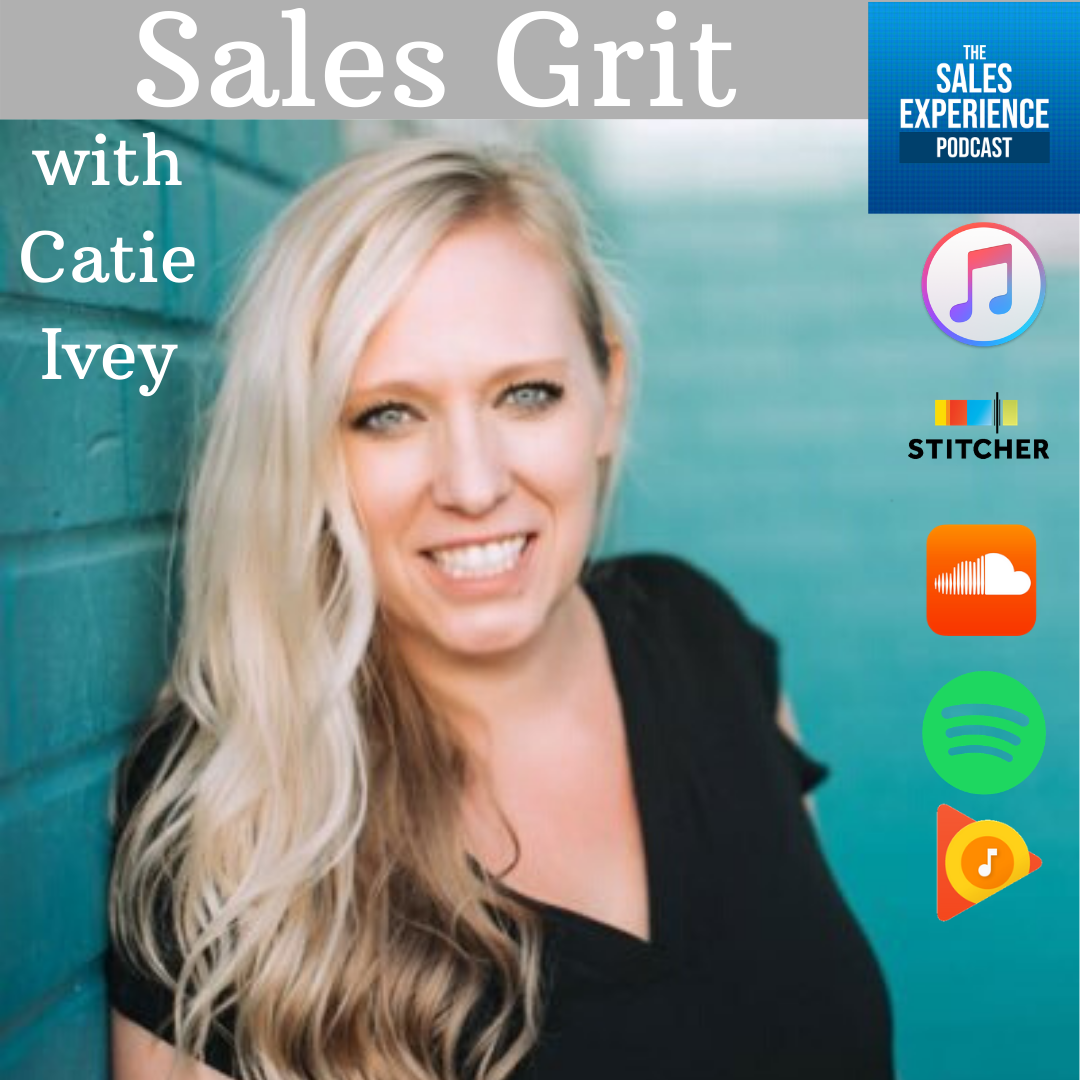How do you ensure that you set clear and achievable expectations with your clients to establish trust and avoid misunderstandings?
E155: Sales Grit with Catie Ivey - Part 4 of 4
This is part four of the conversation I had with Catie.
In Part 4, Catie and I talk about:
- Your prospects don’t know your process, so stop assuming they do
- And…don’t get desensitized to your prospect’s issues, goals, and feelings
- Bringing it all back to curiosity and grit
- Sales rep’s talking too much
Download The Power of Authentic Persuasion ebook
Enroll in the Authentic Persuasion Online Course
Connect with Jason on LinkedIn
Connect with Catie on LinkedIn
Catie’s Info:
Catie is a seasoned sales leader with a passion for coaching and people development and a track record of quota attainment, driving YoY growth, and building a cultivating true value selling methodologies within an organization.
She believes that great cultures produce great results, that empowered people empower others, and that there is no limit to what a team of gritty, hardworking, genuinely curious people can do when they are committed to winning together.
She is an avid proponent of the power and possibility of digital transformation, a lover of all things digital, and genuinely enthusiastic about technology’s ability to drive human connection. She believes that great brands build great connections and harness best in class technology to drive genuine engagement and build real relationships, which has turned her into a MarTech enthusiast with a love for all things sales and marketing.
Catie’s Links:
LinkedIn: https://www.linkedin.com/in/catieivey/
Twitter: https://twitter.com/catiecoutinho
DemandBase: https://www.demandbase.com/
-
Show Transcript
Jason: Welcome back to the sales experience podcast. My name again is Jason Cutter. So glad that you’re here and you’re tuning into the final part, part four of my conversation with Catie Ivey. Now please make sure to have listened to parts one, two and three prior to this because the conversation we just have is just continuing on and she is so dynamic and we cover so many topics from leadership and sales and success and recruiting and women and their value in sales and leadership and some of the challenges that happen with sales reps and we just continue on this conversation. So make sure to check out those parts. Make sure to go to the website, which I’ll mention at the very end so you can get all of Catie’s links, which she’ll also cover the transcript. Please reach out to her. She is powerful and dynamic and here is part four.
Catie: And I think if you can lay that foundation of a ton of mutual respect and transparency from day one, then it’s going to feed into the whole process and it’s going to give both the seller and the customer a lot of comfort and understanding this is what our process looks like. I in no way have a guarantee from you that you’re going to buy for me, but I do have a bit of a guarantee that we’re going to work through this together. And if for whatever point we need to part ways, and you have to tell me no, you feel comfortable to do that.
Jason: I think that is an amazing reminder. Um, I think a lot of, let’s say people like you and I, we just do it naturally. And a lot of salespeople I’ve seen like the professionals, they do that naturally, but it’s always important to set those expectations during the sales process. So here’s what it’s gonna look like. Here’s what I’m going to do. Here’s what you need to do, here’s where we’re going to go, here’s the journey. And then once the deal is actually done and everything has been signed or they have agreed, it’s like, okay, then what’s the expectation moving forward? Like what are we going to do? And then you as the customer, what is the expectation of what you’re going to have to deliver? Because sometimes, especially B2B customer signs up, they agree, they think this is cool, I just bought this or I just hired them. Now I don’t have to do anything and I can put my head back in the sand. Yet there’s a bunch of stuff that they have to do an onboarding or information or training and they have to take part of it. And so setting the expectation before, during, and after the sales process Soki no matter what B to C, B2B doesn’t matter, like just set out that framework
Catie: And you’re right, it may come natural to people that have been doing it for a long time. It’s so funny though, even, and I have some amazing sellers that work for me, but we can easily forget that the people we’re selling to don’t go through this process all day, every day with this laundry list of customers. So we just get into our mode where this is what our demos look like. And this is usually our third call and fourth call. And it feels really robotic as opposed to what you and I just described in terms of this is a mutual process that we’re creating transparency around and a lot of understanding and it’s gotta be about human beings on both sides.
Jason: And that is another great reminder because sales reps and anybody just over time, if you’re not careful, just get desensitized and tuned out to the personal nature of it. And again, you’re just going through the motions. You’ve seen it so many times, you know what’s going to happen. So you know the end of the movie, but they don’t and you want to make sure they know it. And then also, I’ve seen this a lot where salespeople in the beginning, they get really excited. They want to help the customer. They learn a lot about the customer, they care, you know, taking it personal, hopefully in a good way. And they want to, you know, help somebody improve their life in some way, their life, their business, whatever that looks like. And then over time it’s just another person, another phone call and another demo and just stop, like realizing it’s another person and just kind of go into a, let’s just say like DMV worker mode where it’s just another person in line with another form and you’re just tired of it and you know what’s going to happen and it doesn’t matter. And I see that with sales reps all the time that if you’ve done it for any length of time, you just lose that connection with why.
Catie: There you go with the visuals again. I love it.
Jason: Everyone’s been to the DMV. For anyone listening outside the U S I also know that there’s DMV like, uh, situations or government offices. So just imagine dealing with government workers. You never want to get there in your sales career. Never, uh, at least not on accident. Maybe on purpose. If that works for you, but they’re not. So we talked about successful reps where they, you know, the gritty, the curious, the never stopping, always wanting to learn, unsuccessful reps, obviously missing the curious parts. What other traits do you see in unsuccessful reps like the order taker example that they can then fix, right? Not just like you’re unsuccessful, you need to go somewhere else, but what are they missing that they could also work on? Outside of that?
Catie: I mean the most general and basic thing that I see so often is that they’re really bad at listening. So typically it comes from a place of being nervous and not confident yet. So they’re so fixated on what they need to say or what question might come up that they won’t know the answer to. And because of that, they don’t do a good job of truly listening, even in such a way as to be able to acknowledge, wait, I don’t think I understood what you just said, or maybe I didn’t hear you right. Being willing to say something like that when you genuinely don’t understand something is so, so important. And then of course with that nervous sellers tend to also just talk and talk and talk because they’re so afraid they might miss something or that they’re just afraid to lose control of any situation.
Catie: I mean, so that’s like sales one-on-one like the where sales reps that struggle tend to be really poor at listening and then they tend to be relatively poor at being able to think on their feet or incorporate conversation or feedback or questions that they’re getting. I mean, they think of the concept of like layering questions. Being able to go one step deeper and incorporate what they’re hearing into, Oh, based on that, let’s steer the conversation in this way. Or man, you’re going to love this part of our product because of what you just said. That’s the part that I think is a little bit harder to teach, so that ability to pivot quickly. I think for folks that struggle with that, it’s really important as a sales leader to hone in on the strengths and figure out what are some other things that they’re naturally good at that can offset some of that.
Catie: I managed a rep back during my Marketo days that struggled a bit with that thinking on their feet and being able to pivot quickly, but she was so, so, so good at building relationships. People just love her. So literally that’s what we focused on because people would give her much grace even to literally stop and think like, wait, I’m not quite sure what to do with that information. They’d liked her so much that like she could do that in a way that others couldn’t because they weren’t so natural at that relationship piece. But yeah, those two things come to mind in terms of reps that can be a little bit weaker and why they struggle
Jason: And that listening one is so valuable. The biggest thing I’ve told sales reps and teams forever like when they’re new is your number one goal is to learn everything that you need to with the technology, with the phone, with your service or product that you’re selling and the script such that you can get to the point where you no longer have to think about what you’re going to do next and you can actually listen and have a conversation with another human and care as a human right. So the faster you can get to the point where you’re no longer worried about talking, typing, reading, writing, calculating, doing all these things, running your slideshow, running your demo, you know whatever contracts you need them to sign. Like as soon as all of that is autopilot is how quickly you will be successful in sales or have a shot at it at scale and consistently when you can just kind of like this, right? We have some stuff that we’re talking about. I have some ideas of what I wanted to ask you and where this might go, but literally this whole thing is a conversation that’s gone all over the place, which is way more authentic and way more effective than if this was like planned out and scripted and you know all that.
Catie: Yeah, 100% and I will say using sales recording technology has definitely helped as a manager, made that process much easier for me to coach reps on. Even just the fact that they can now easily look at, okay, out of the last eight calls I ran, here’s the percentage of time that I talk versus the percentage of time that my customers talk. I mean that’s a very, I can coach to that metric. Hey, next week I want the numbers to look like this. And they can go do it. Like it’s very simple and actionable. And for reps that may struggle with talking too much or not being great listeners, it makes it very tangible to know that there’s something that they can focus on getting better at.
Jason: What’s that number that you’d like to see in that talking percentage?
Catie: So it differs depending on the part of the sales process and what it is that you’re showing and doing. I mean for a discovery call, 60% or more of the customer talking is the dream scenario from my perspective and then I think it shifts as you get into product demos and then flips back again as you get later stage and there’s much more dialogue.
Jason: Well for the demo stage, because it’s great that you brought up those different parts because you try to lump them all together, it’s going to be a terrible percentage that doesn’t accent for the demo. What do you see? Is it more like 80% rep?
Catie: Yes, that’s definitely the more the generic that I see across my team. I will say that with ABM software we deal with a lot of different types of buyers. Some are more on the operation, the marketing ops or the rev ops side and they tend to be much more tactical around the product. So they have very specific questions and they tend to, we need them engaging more because it’s not sort of the typical big picture, here’s top line business objectives and how the product’s going to do all of that. So when we are in more of the tactical operational guys, even with the demo portion, there tends to need to be more dialogue and more talking this coming from the customer versus we’ve got a COO or a CRO that’s evaluating lots of dialogue when we come to the discovery portion. But typically they want to get like, show me your product. And so I’m not going to force them to pretty driving and talking through the entire process.
Jason: That makes sense. And there’s, there’s always different buyers who, the ones who are curious and like you said, different layers in the organization where some you’re going through a demo, they’re not making any comments, not providing a lot of interaction, taking the information in. And maybe it’s because they’re at the decision level mark and they know that they’re going to buy it or they’re reporting it on versus other ones. So, and then what about that third stage, you know, post demo follow up. What do you like to see percentage wise?
Catie: Ideally always, always more than 50% of a customer or prospect talking is just the generic great scenario for me. But again, it definitely depends on the individual
Jason: And you are absolutely correct. There’s so much technology outright now that’s available. You know, you mentioned gong, there’s refract, there’s so many other different systems you can use as a sales manager to pump in your phone calls, have it spit out all these analytics that we’d never had before growing up as sales managers, right? Where it was just more intuitive and you could listen and be like, dude, you’re talking too much. And so, you know, there’s a lot of great ways to scale what is generally unscalable as a salesman.
Catie: I have memories literally of my first manager sitting next to me with one of those old school like listening headsets on and like trying to like text me what to say next. So yeah, the technology’s come a long way. Yeah.
Jason: Okay. So before we go and we’re running really late, but I want to just clarify a couple of things because not all of my listeners are in the B to B space or not, uh, you know, doing what you do. You mentioned some terms and I just want you to clarify or kind of explain kind of what it means relative to what you guys do. ABM, CMO and CRO
Catie: ABM is an account based marketing. So essentially technology that helps B to B organizations go to market in a very account centric way. So selling to wholistic companies versus selling to leads or contacts or individual people. So it’s really the shift that we’re seeing in business to business marketing. A COO is a chief marketing officer, um, owns the marketing org for an entire company. And then CRO is chief revenue officer. So in most companies the CRO will own like sales, customer success and sometimes well marketing.
Jason: Perfect. Makes sense. Catie. Thank you. No, no, no. I love it. I think it’s great. But, uh, I know for me where I’ve spent a lot of times in my, in organizations, there’s not this thing called the COO or it’s called something else and or a CRO and a, I think it’s interesting as kind of the business is shift to revenue ops taking the umbrella of more things and tying them all together, which is what I love. Yeah. I love that. Well, thank you for being on the show with me and having a fun conversation and a journey through all different stuff with sales. So I appreciate you being here.
Catie: Yeah, it was great to meet you. Thanks so much for the time.
Jason: So where can people find you, find what you’re doing online, your company? Where’s some good links for them?
Catie: Yeah, so LinkedIn is definitely my preferred method. Um, I engage there pretty consistently, probably more than I should cause I get sucked into all kinds of conversations. So you can find me. I’m Catie with a C uh, so I can decay you with a CKD IB. I’m pretty easy to find. I’m also actively engaged on Twitter, so I’m in there as well.
Jason: And you’re doing a lot of great leadership stuff, especially in the female sales leadership role. So anybody listening to this, definitely make sure reach out to Catie and thanks again for being on the show. Alright, and for everyone else, make sure to go to cutterconsultinggroup.com you can go to find this podcast, the transcript, all of Catie’s links. And as always, keep in mind that everything in life is sales and people remember the experience you gave them.
Become a Certified Authentic Persuader
Get the ebooks to help you close more deals
Visit
Selling Effectiveness for more tips and get help
Follow Jason on LinkedIn
Or go to Jason’s HUB – www.JasonCutter.com






Phone: (239) 206-1919 | Email: info@sellingeffectiveness.com
Copyright © 2023 Selling Effectiveness Institute. All rights reserved.







